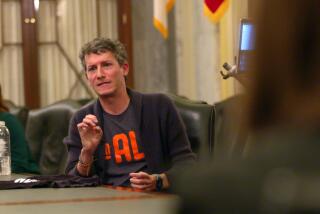For David Foster Wallace’s survivors, a paper puzzle
- Share via
Anybody familiar with the work of David Foster Wallace would not be surprised to hear that the deal for his last -- and posthumous -- book came together in a nontraditional way.
Notes his longtime agent Bonnie Nadell, Wallace often worked without a contract and never much cared about the peripherals -- not publicity, not money -- nothing but getting the right words on the page. Both achingly shy and unself-promotingly self-promoting, he was known not to bow to conventional wisdom.
So it follows that even in death -- Wallace, 46, committed suicide Sept. 12 at his home in Claremont -- he remained, in his haphazard and disorganized fashion, in control of his literature and his legacy.
It may be fantasy, but most people suspect that when a famous writer dies, the next of kin or literary executor approaches an agent, editor or university with his or her papers and tries to make a deal.
But this being Wallace, the process was both simpler and more complex.
According to Nadell, there was never any question as to who should put out whatever Wallace left behind. For the last 12 years of his life -- beginning with his iconic 1996 novel, “Infinite Jest” -- he was published by Little, Brown and edited by Michael Pietsch.
The author had no option with Little, Brown, but Pietsch was one of only two editors Wallace ever had -- the other, Gerry Howard, is now at Doubleday.
Initially, however, the nature of what he’d left behind remained unclear. There was a lot of writing, to be sure -- hundreds of thousands of words worth -- but it was difficult to determine exactly what it was.
In part, this was because for weeks after Wallace’s death, Nadell and the author’s widow, artist Karen Green, were unable to venture into the garage office in which he worked. “We’d get two inches in there,” says Nadell, “and it felt haunted. We’d turn around and leave.”
In early January, Pietsch came to Claremont to go through a number of those “big plastic things from Target,” as well as dozens of bags and notebooks and disks (the old-fashioned floppy kind). What he found were drafts and notes and fragments of Wallace’s last, unfinished novel, “The Pale King.”
The book, excerpted in the New Yorker this week, alongside an extensive piece about the author’s life and final days by D.T. Max, is about someone who goes to work at -- of all places -- the IRS. To research the book, Green tells Max, Wallace badgered his accountant and studied IRS publications, some of which were discovered among the morass of papers in his office.
“It’s just unbelievably fascinating that he could write a novel about the most boring and unpleasant parts of life and make it interesting and exciting and worth writing about,” Pietsch says. “This is the stuff that our life is really made of, and the challenge is to find a way to be happy.”
There was never any desire to shop the material, and nobody asked Pietsch to make a bid. “If Michael didn’t think it was publishable, I would have just put it away,” Nadell says. Pietsch stayed four days and never debated taking on the project.
Still, realizing that he couldn’t get through everything even if he read all day every day “from dawn to dusk,” Pietsch loaded one of Wallace’s old green duffel bags -- “I could barely lift it onto my shoulder,” he remembers -- and boarded a flight back to New York.
There were no extra copies, no promises, and, needless to say, he didn’t check the bag.
“I told him,” Nadell says, “that this was either going to be the greatest editorial project you’ve ever worked on -- or you’re going to have a nervous breakdown.” Among the risks? That of fetishizing Wallace, of turning him into a Kurt Cobain-type figure, whose death -- or even more, his lost potential -- might overshadow his work.
Eventually, Nadell and Pietsch struck a deal for North American rights for an undisclosed sum.
Today, the pages of “The Pale King” sit in bins and boxes around Pietsch’s desk at home, but he bristles at the suggestion that he won’t get through them in time to publish the novel, as he has promised -- and as Little, Brown has announced -- in the spring of 2010.
It doesn’t seem to faze him that among the various drafts are sometimes “10 different versions of one chapter or one scene.”
Indeed, Pietsch insists -- as he did years ago when, as an editor at Scribner, he published Ernest Hemingway’s posthumous, unfinished book about bullfighting, “The Dangerous Summer” -- that he will not rewrite.
“You do not change a word if someone’s not there to argue with you or discuss it with you,” he says.
What this means is that he has his work cut out for him. “It’s not clear what the intended structure was,” Pietsch admits, although Wallace left copious outlines and notes about “The Pale King” that he will use as guides. The published book “will just stop where it stops,” and may include some of Wallace’s notes and journals.
“I was thinking, as Michael and Karen and I were moving boxes of papers into my Honda,” Nadell says, “that this is all so typical of David. So typical to leave a situation and think, ‘It’ll figure itself out.’ ”
Famous for setting monumental challenges in his work and in his life, Wallace has -- wittingly or not -- set the same sort of challenge in death for the people who loved him most, the people he left behind.
More to Read
Sign up for Essential California
The most important California stories and recommendations in your inbox every morning.
You may occasionally receive promotional content from the Los Angeles Times.










